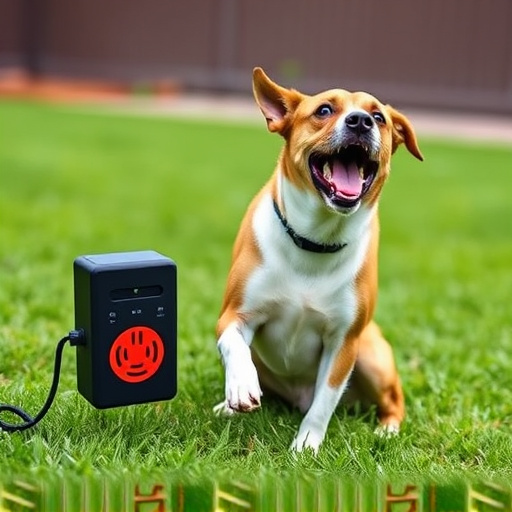Dogs have an enhanced sense of hearing that allows them to detect ultrasonic sounds humans can't. This has led to the development of Safe Ultrasonic Frequencies for Dog Control, a humane alternative to traditional training methods. Devices using these frequencies gently deter dogs from unwanted behaviors without causing harm, promoting canine safety and human-animal well-being. These sonic trainers leverage natural sound sensitivity, encouraging positive behavior through subtle stimuli rather than negative reinforcement. With proper usage guidelines, they offer a modern, effective solution for behavior guidance while fostering stronger owner-pet bonds.
“Discover the revolutionary power of safe ultrasonic frequencies for dog control with our in-depth look at sonic animal training safety devices. This article explores how these innovative tools utilize specific sound waves to train dogs without resorting to harmful methods. From understanding the science behind ultrasonic frequencies and their impact on canine behavior, to practical guidelines for responsible use, we provide a comprehensive guide. Learn about the advantages of this modern approach over traditional training methods, ensuring your furry friend’s well-being while achieving obedience goals.”
- Understanding Ultrasonic Frequencies and Their Effect on Dogs
- The Science Behind Sonic Animal Training Safety Devices
- Ensuring Safe Use: Precautions and Guidelines for Dog Owners
- Comparing Traditional Training Methods: Advantages of Ultrasonic Frequencies
Understanding Ultrasonic Frequencies and Their Effect on Dogs
Dogs, like many mammals, have a sensitive hearing range that allows them to detect sounds well beyond human capabilities. Understanding ultrasonic frequencies is crucial when considering their impact on canine behavior and safety. Ultrasonic sounds are above the human hearing threshold, typically ranging from 20 kHz to 100 kHz or more. However, dogs can hear and respond to sounds up to 60-80 kHz.
The use of safe ultrasonic frequencies for dog control has emerged as a humane alternative to traditional training methods. These devices emit high-frequency sound waves that are inaudible to humans but can be detected by dogs. When a dog approaches or interacts with an object emitting these sounds, they receive a gentle reminder without the need for physical punishment or negative reinforcement. This approach is particularly useful for managing unwanted behaviors like barking, jumping, or aggression, ensuring both canine safety and human-animal well-being.
The Science Behind Sonic Animal Training Safety Devices
The Science Behind Sonic Animal Training Devices focuses on using safe ultrasonic frequencies to control dog behavior. These devices emit high-frequency sound waves that are inaudible to humans but can capture a dog’s attention and alter its behavior. The technology leverages a dog’s natural sensitivity to sounds, leveraging a range of safe ultrasonic frequencies tailored for specific training needs. Unlike traditional methods that rely on negative reinforcement or punishment, this approach encourages positive behavior through subtle, non-harmful stimuli.
Research has shown that dogs can respond effectively to ultrasonic tones without experiencing any physical discomfort or harm. The device’s ability to target specific behaviors, such as barking or jumping, allows for precise training. Additionally, the use of safe ultrasonic frequencies promotes a more positive and effective training environment, fostering a stronger bond between the owner and their pet while addressing unwanted behaviors humanely.
Ensuring Safe Use: Precautions and Guidelines for Dog Owners
When considering a sonic animal training safety device, especially one that uses ultrasonic frequencies for dog control, it’s paramount for dog owners to prioritize their pet’s well-being. While these devices are designed to guide and correct canine behavior without physical harm, proper usage is crucial to ensure safe and effective results. Always follow the manufacturer’s guidelines strictly, as they provide essential information on safe ultrasonic frequencies and usage limits.
To guarantee a secure training environment, dog owners should keep these precautions in mind: avoid targeting dogs with any sound level that might cause discomfort or pain; never leave the device activated for extended periods; and maintain a safe distance while operating it to prevent any potential harm. Regular breaks during training sessions are recommended, allowing your dog to adjust and associate the ultrasonic signal with positive behavior reinforcement rather than fear.
Comparing Traditional Training Methods: Advantages of Ultrasonic Frequencies
Many traditional dog training methods rely on punishment-based techniques, such as shock collars or loud noises, which can cause fear and anxiety in animals. These methods often lead to negative associations and may result in aggression or a lack of trust between the pet and owner. In contrast, safe ultrasonic frequencies for dog control offer a modern, humane alternative.
Ultrasonic devices emit high-frequency sound waves that are inaudible to humans but can be heard by dogs. This technology has several advantages. It’s effective in guiding canine behavior without causing physical harm or psychological distress. Dogs learn to associate the specific ultrasonic tone with desired actions, making training more positive and rewarding. Additionally, these devices can be a consistent and reliable tool for reinforcing good behavior, ensuring a happier, healthier relationship between pets and their owners.
Ultrasonic frequencies, when used responsibly and within safe limits, offer a modern and effective approach to dog training. Sonic animal training safety devices provide an alternative to traditional methods, ensuring well-being and minimizing potential harm to pets. By understanding the science behind these devices and adhering to precautions outlined in this article, dog owners can effectively manage their pets’ behavior while maintaining a harmonious relationship based on safe ultrasonic frequencies for dog control.
